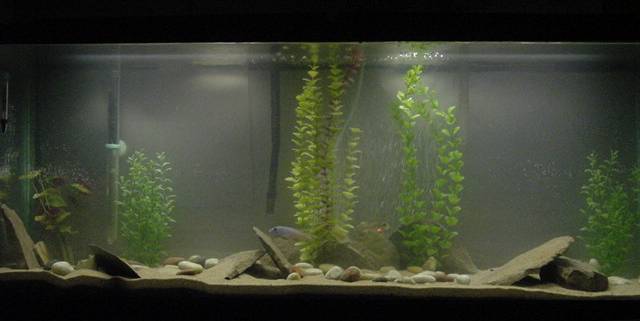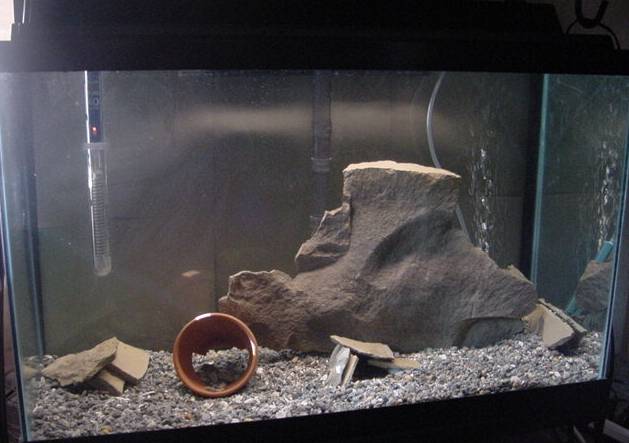|
|
|
Aquarium Basics
You are probably wandering what are some of the first things you need to get your fish keeping experience started. If you walk into a fish store for the first time you will find that you will be overwhelmed with the various equipment and supplies that are available. Most of what you will find there would be listed under the not very necessary category.
Since most of you do not know to walk into a fish store for the first time with a list in hand, then after reading this you will be able to save a lot of time and a lot of money with your very own list!
Here is a checklist of the most important items to purchase:
□ Tank
□ Stand
□ Substrate and decorations
□ Cover and Light
□ Heater and Thermometer
□ Mechanical Filter and Bio-filter
□ Water Test Kits (two sets)
□ Aquarium Salt
□ Water Dechlorinator/ conditioner
□ Ich Medication
□ Bucket and Siphon Hose
□ Algae Scraper
□ Net
If you’d like you can print out this list so you can take it with you when you go. I am going to cover each item individually to help you make the best selection.
Let’s start with the tank. Most people feel that a “starter kit” is the best way to go but in fact they do not contain all the equipment that you will need to get you started. Some require you to buy a heater and some a filter. On the other hand they may contain unnecessary things you really don’t need. They also tend to promote a much smaller tank than what is needed.
Tank size is a very important factor in planning for your fish experience. If it is at all possible, as far as budget and amount of room needed for the tank goes, pick the largest tank you can get. The larger tanks are much easier to clean and maintain than the smaller ones. You can also keep more varieties of fish and you have room to grow into.
I highly recommend a glass tank. Acrylic tanks are lighter and more resistant to jarring, but they are also more expensive and scratch easier. For a first tank choose the glass. Once you have more experience then it will be worth the investment and satisfaction.
As far as shape goes, well everyone has their opinions on this but the one opinion that counts more is your fish. If you are planning on keeping cichlids or catfish they stake out their territories on the bottom so if you bought them a tank that is tall and deep with the floor size minimal then it really wouldn’t be a good tank for them. They would never use the upper portions of the tank. These types of tanks are more useful in the community settings. Gourami’s that inhabit the top portions, barbs in the middle and Cory catfish on the bottom. For the cichlid and catfish lovers you would be best to get an aquarium that may hold the same amounts of water but be lower and wider to provide more surface area on the bottom to allow for territory. It is important to note that the shape of an aquarium is more important than how many gallons it holds.
No matter what tank you decide to purchase, be sure that you purchase an equally stable stand for it to sit on. Tops of dressers or tables do not make the best stands for your aquarium. For every gallon of water you have in your tank the weight would equal 8lbs per gallon. If you have a ten gallon tank, just filled with water it would weigh 80 pounds!!! That’s more than most TV’s weigh. That’s more than my seven year old daughter weighs and she is much bigger than a ten gallon tank. Buy only stands that are recommended for the tank you are purchasing.
Substrate and decorations are the easiest part. You can virtually decorate
your tank with anything that would be deemed safe for the fish. Here is
an example. I raise cichlids and the bag of cichlid substrate at the fish

store was $22. It is designed to keep the water hard and maintain a high ph. My water is already hard, has a high ph, and nothing that I have ever tried would bring it down enough to keep the fish I wanted to keep. Now after doing some research I discovered that limestone is a great substrate and decoration for tanks that are holding cichlids. Well I was happy, living in the limestone capital of the world I went to the highway and picked up a whole bucket full of the stuff and brought it home. The fish loved it! I used sand as the substrate which makes them even happier. They can suck it through their mouths where they strain it for micro-organisms that they naturally feed on.
As you can see it really depends on what type of fish you are keeping and if you want to go all natural or keep it more towards your taste. Plants make a good decoration. Live plants are beautiful but can be expensive to keep. That will be covered in another article I am writing, so for now let’s keep with the basics and get the equipment.
Some tanks can be purchased with the cover and light and some you have to purchase them separately. I prefer the florescent over the incandescent any day. The light is much brighter and they last longer. There are many types of florescent bulbs you can buy and it will really depend on the type of fish you buy, but just the aquarium bulb should do. You will defiantly want to invest in a proper cover so that you can avoid the fuzzy fish syndrome. Any fish will jump if it can.
A floating thermometer will work quite nicely. These are nice if you have more than one tank. I use one between two and three tanks to check temps in the AM when I do the rounds. You need to make sure that the temps do not fluctuate more than a few degrees a day. Which leads me to heaters. Most brands are pretty reputable but it is the type that makes the heater. Invest in a submersible heater. The ones that clip on the back of the tank are not trustworthy and do not keep the temps regulated enough. One very nice discovery that I made was a filter with the heater built into it. It warms the water as it is filtered and returned to the tank. These types of heater/filter combos are nice, especially if you own an Oscar who gets bored!
Filters are plentiful and choosing the right one can be difficult. There are three types of filtration that you will need for your tank. Mechanical, chemical, and bio. Mechanical filtration is the physical trapping of pieces of dirt, waste and food that is unable to pass through the fibers of the fiber medium. Chemical filtration is usually made up of activated charcoal which absorbs water contaminants. Bio filtration enables your fish to survive. When you use mechanical or carbon filtration there is usually a visible result, bio filtration however removes substances we cannot see and replaces them with other substances we cannot see. Sound confusing? It isn’t. (see article on tank cycling) It is just a process that is so small that it cannot be seen by the naked eye. As long as you remember that biofiltration removes harmful ammonia and nitrites from the water by culturing various bacteria that convert those substances into nitrates, which are much less directly harmful. In fact they are not harmful at all unless they are left to build up to high levels. The perfect filter would be one that will supply your tank with all three types of filtration.

That leads us to test kits. They let us look into the world of the micro-organisms that are living in your tank and letting us see how they are doing. You can buy test kits that will test for everything, but you really only need to test for these basic perimeters. The three basic tests are pH, alkalinity, and hardness. It is important that you know these parameters for your water supply and that you monitor them on a regular basis.
The other three tests you will need will test ammonia, nitrite, and nitrate. I have an article on tank cycling and it will explain testing for these three parameters.
Aquarium salt is more of a medicinal although some species of fish actually require it to survive. Before you do your fish shopping I advise you to research the type of fish you want to get and learn more about the habitats and requirements.
Water dechlorinator and conditioner is the only chemical I recommend for any tank. Ich medication is a must have when starting out. Changes in water and exposure to other infested fish can trigger an ich outbreak and you will want to be prepared for this in any event.
A bucket marked “FISH ONLY” is a must. This has to be a brand new bucket and must NEVER touch soap. Even the tiniest amount of soap particle can kill your fish. You will also need a syphoning hose to change the tank water. I recommend just getting a PYTHON as you can use it to drain, clean gravel, and fill all in a few easy steps. It was the best thirty dollars I ever spent. You can find them at Wal-Mart and are defiantly a must have for any aquarist. You will also need an algae scrubber. It comes with a handle or you can just buy a pad. Make sure it is fish safe. SOS pads are defiantly not what you want to use.